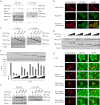Aicardi-Goutières syndrome protein TREX1 suppresses L1 and maintains genome integrity through exonuclease-independent ORF1p depletion
- PMID: 28334850
- PMCID: PMC5416883
- DOI: 10.1093/nar/gkx178
Aicardi-Goutières syndrome protein TREX1 suppresses L1 and maintains genome integrity through exonuclease-independent ORF1p depletion
Abstract
Maintaining genome integrity is important for cells and damaged DNA triggers autoimmunity. Previous studies have reported that Three-prime repair exonuclease 1(TREX1), an endogenous DNA exonuclease, prevents immune activation by depleting damaged DNA, thus preventing the development of certain autoimmune diseases. Consistently, mutations in TREX1 are linked with autoimmune diseases such as systemic lupus erythematosus, Aicardi-Goutières syndrome (AGS) and familial chilblain lupus. However, TREX1 mutants competent for DNA exonuclease activity are also linked to AGS. Here, we report a nuclease-independent involvement of TREX1 in preventing the L1 retrotransposon-induced DNA damage response. TREX1 interacted with ORF1p and altered its intracellular localization. Furthermore, TREX1 triggered ORF1p depletion and reduced the L1-mediated nicking of genomic DNA. TREX1 mutants related to AGS were deficient in inducing ORF1p depletion and could not prevent L1-mediated DNA damage. Therefore, our findings not only reveal a new mechanism for TREX1-mediated L1 suppression and uncover a new function for TREX1 in protein destabilization, but they also suggest a novel mechanism for TREX1-mediated suppression of innate immune activation through maintaining genome integrity.
© The Author(s) 2017. Published by Oxford University Press on behalf of Nucleic Acids Research.
Figures






Similar articles
-
Dominant mutation of the TREX1 exonuclease gene in lupus and Aicardi-Goutieres syndrome.J Biol Chem. 2011 Sep 16;286(37):32373-82. doi: 10.1074/jbc.M111.276287. Epub 2011 Aug 1. J Biol Chem. 2011. PMID: 21808053 Free PMC article.
-
TREX1 deficiency triggers cell-autonomous immunity in a cGAS-dependent manner.J Immunol. 2014 Jun 15;192(12):5993-7. doi: 10.4049/jimmunol.1400737. Epub 2014 May 9. J Immunol. 2014. PMID: 24813208
-
Cutting Edge: cGAS Is Required for Lethal Autoimmune Disease in the Trex1-Deficient Mouse Model of Aicardi-Goutières Syndrome.J Immunol. 2015 Sep 1;195(5):1939-43. doi: 10.4049/jimmunol.1500969. Epub 2015 Jul 29. J Immunol. 2015. PMID: 26223655 Free PMC article.
-
Aicardi-Goutières syndrome.Handb Clin Neurol. 2013;113:1629-35. doi: 10.1016/B978-0-444-59565-2.00031-9. Handb Clin Neurol. 2013. PMID: 23622384 Review.
-
Human disease phenotypes associated with mutations in TREX1.J Clin Immunol. 2015 Apr;35(3):235-43. doi: 10.1007/s10875-015-0147-3. Epub 2015 Mar 4. J Clin Immunol. 2015. PMID: 25731743 Review.
Cited by
-
Repetitive elements in aging and neurodegeneration.Trends Genet. 2023 May;39(5):381-400. doi: 10.1016/j.tig.2023.02.008. Epub 2023 Mar 17. Trends Genet. 2023. PMID: 36935218 Free PMC article. Review.
-
The Regulation and Immune Signature of Retrotransposons in Cancer.Cancers (Basel). 2023 Aug 30;15(17):4340. doi: 10.3390/cancers15174340. Cancers (Basel). 2023. PMID: 37686616 Free PMC article. Review.
-
TREX1 - Apex predator of cytosolic DNA metabolism.DNA Repair (Amst). 2020 Oct;94:102894. doi: 10.1016/j.dnarep.2020.102894. Epub 2020 Jun 12. DNA Repair (Amst). 2020. PMID: 32615442 Free PMC article.
-
Sensing of transposable elements by the antiviral innate immune system.RNA. 2021 Jun 16;27(7):735-752. doi: 10.1261/rna.078721.121. RNA. 2021. PMID: 33888553 Free PMC article. Review.
-
Diseases of the nERVous system: retrotransposon activity in neurodegenerative disease.Mob DNA. 2019 Jul 26;10:32. doi: 10.1186/s13100-019-0176-1. eCollection 2019. Mob DNA. 2019. PMID: 31372185 Free PMC article. Review.
References
-
- Gehrke N., Mertens C., Zillinger T., Wenzel J., Bald T., Zahn S., Tuting T., Hartmann G., Barchet W.. Oxidative damage of DNA confers resistance to cytosolic nuclease TREX1 degradation and potentiates STING-dependent immune sensing. Immunity. 2013; 39:482–495. - PubMed
-
- Luan D.D., Korman M.H., Jakubczak J.L., Eickbush T.H.. Reverse transcription of R2Bm RNA is primed by a nick at the chromosomal target site: a mechanism for non-LTR retrotransposition. Cell. 1993; 72:595–605. - PubMed
Publication types
MeSH terms
Substances
Supplementary concepts
Grants and funding
LinkOut - more resources
Full Text Sources
Other Literature Sources

